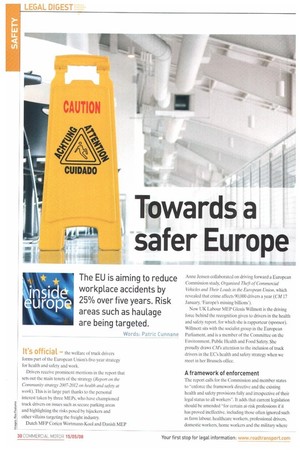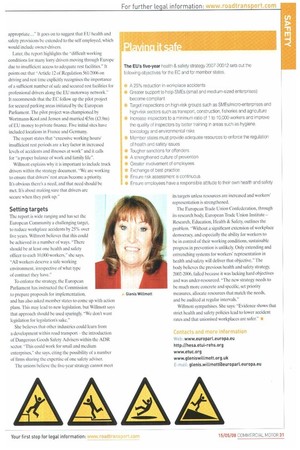Towards a safer Europe
Page 30

Page 31

If you've noticed an error in this article please click here to report it so we can fix it.
The EU is aiming to reduce workplace accidents by 25% over five years. Risk areas such as haulage are being targeted.
Words: Patric Cunnane s official the welfare of truck drivers forms part of the European Union's five-year strategy for health and safety and work.
Drivers receive prominent mentions in the report that sets out the main tenets of the strategy (Report on the Community strategy 2007-2012 on health and safety at work). This is in large part thanks to the personal interest taken by three MEPs, who have championed truck drivers on issues such as secure parking areas and highlighting the risks posed by hijackers and other villains targeting the freight industry.
Dutch MEP Corien Wortmann-Kool and Danish MEP Anne Jensen collaborated on driving forward a European Commission study, Organised Theft of Commercial Vehicles and Their Loads in the European Union, which revealed that crime affects 90,000 drivers a year (CM 17 January, 'Europe's missing billions).
Now UK Labour MEP Glenis Willmott is the driving force behind the recognition given to drivers in the health and safety report, for which she is rapporteur (sponsor). Willmott sits with the socialist group in the European Parliament, and is a member of the Committee on the Environment. Public Health and Food Safety. She proudly draws CM'S attention to the inclusion of truck drivers in the EC's health and safety strategy when we meet in her Brussels office.
A framework of enforcement The report calls for the Commission and member states to "enforce the framework directive and the existing health and safety provisions fully and irrespective of their legal status to all workers". It adds that current legislation should be amended "for certain at-risk professions if it has proved ineffective, including those often ignored such as farm labour. healthcare workers, professional drivers, domestic workers, home workers and the military where appropriate..." It goes on to suggest that EU health and safety provisions be extended to the self employed, which would include owner-drivers.
Later, the report highlights the "difficult working conditions for many lorry drivers moving through Europe due to insufficient access to adequate rest facilities." It points out that "Article 12 of Regulation 561/2006 on driving and rest time explicitly recognises the importance of a sufficient number of safe and secured rest facilities for professional drivers along the EU motorway network." It recommends that the EC follow up the pilot project for secured parking areas initiated by the European Parliament. The pilot project was championed by Wortmann-Kool and Jensen and married €5m (J3.9m) of EU money to private finance. Five initial sites have included locations in France and Germany.
The report states that "excessive working hours/ insufficient rest periods are a key factor in increased levels of accidents and illnesses at work" and it calls for "a proper balance of work and family life".
Willmott explains why it is important to include truck drivers within the strategy document. "We are working to ensure that drivers' rest areas become a priority. It's obvious there's a need, and that need should be met. It's about making sure that drivers are secure when they park up."
Setting targets The report is wide ranging and has set the European Community a challenging target, to reduce workplace accidents by 25% over five years. WiIlmott believes that this could be achieved in a number of ways. -There should be at least one health and safety officer to each 10,000 workers," she says. "All workers deserve a safe working environment, irrespective of what type of contract they have."
To enforce the strategy, the European Parliament has instructed the Commission to prepare proposals for implementation, and has also asked member states to come up with action plans. This may lead to new legislation. but Vvillmott says that approach should be used sparingly. "We don't want legislation for legislation's sake."
She believes that other industries could learn from a development within road transport the introduction of Dangerous Goods Safety Advisers within the ADR sector. "This could work for small and medium enterprises," she says, citing the possibility of a number of firms sharing the expertise of one safety adviser.
The unions believe the five-year strategy cannot meet




























































































































































































